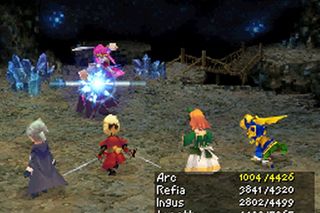Final Fantasy III vs Final Fantasy V - which one rules?
We take a look at two handheld RPG greats and help you pick a winner
The two titles also introduced several recurring elements to the series. FFIII first introduced many of the series' trademark summoned monsters and was the first game to offer sidequests for optional spells (the Leviathan and Bahamut summons). It also gave us the village of Gyshal, whose produce is beloved by chocobos across the universe.
FFV was the first game to feature optional, exceptionally difficult boss enemies. One of them, Omega, has made a few more series appearances to further torment gaming completists. More notably, FFV marked the first appearance of semi-antagonist Gilgamesh - a multi-limbed warrior who appears fierce at first, but is revealed to be a bumbling lackey with a penchant for collecting knockoff swords. (Many believe that his last stand in Final Fantasy V is what has doomed him to wander through dimensions and reappear in other FF titles. He still can't tell a real sword from a replica in any of them.)

The moogles also first appeared in the original version of FFIII, though in a very minor role and looking much different than their current design. FFV re-introduced them in a more recognizable form, along with their own theme music. Coming around full circle, the FFIII DS remake uses the more modern moogle design, as well as giving the lovable fuzzballs a more prominent place in the game.
So which of these two games holds up the best? The answer: They're both fantastic. Final Fantasy III has benefited greatly from its DS remake - not only does it feature excellent 3D graphics, but it gives the game a stronger story than its original incarnation and also delivers a revamp of the original's class abilities. Final Fantasy V Advance, in comparison, is simply an improved port of the beloved original. It boasts an excellent new translation and a handful of new jobs for players to tinker with, while retaining all of its classic charm. But when it comes right down to it, both games are must-plays - not just as great RPGs, but as important historical landmarks for the Final Fantasy series and the RPG genre as a whole.
Sign up to the GamesRadar+ Newsletter
Weekly digests, tales from the communities you love, and more

Final Fantasy 14 devs more likely "to do something light again" for its next project as "you can kinda tell" Yoshi-P is "done" with Final Fantasy 16's "dark fantasy"

Final Fantasy 7 Rebirth's most painfully boring minigame was originally twice as tedious, but at the last minute Square decided "it might be stressful"
Most Popular


